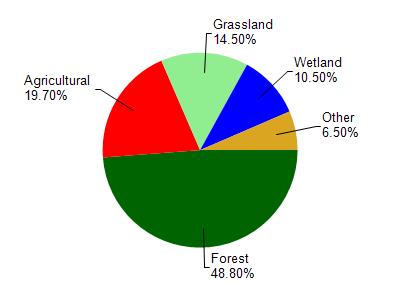Rusk
No
Yes
No
Fish and Aquatic Life
Overview
Bass Lake(T34N R9W S16), in the Lake Chetek Watershed, is a 82.72 acre lake that falls in Rusk County. This lake is an outstanding/exceptional resource water under NR102 under the Fisheries Program. This lake is managed for fishing and swimming and is currently not considered impaired.
Date 2011
Author Aquatic Biologist
Historical Description
Source: 1971, Surface Water Resources of Rusk County Bass Lake, T34N, R9W, Section 16
A soft water, seepage lake with an outlet to a commercial cranberry bog located beyond the west shore. There is a five- foot water diversion dam at the outlet. There is also and intermittent inlet from nearby Lake 21-5. Northern pike and largemouth bass are present, and there is a stunted panfish population consisting of bluegill, black crappie, pumpkinseed and black bullhead. About 25 percent of the shoreline is tamarack bog, and the remainder is upland hardwood and conifer cover. The littoral bottom types include sand, gravel and muck. The lake has moderate migratory waterfowl use and mallard and wood ducks nest there. Muskrats are also common. Private development consist of one resort, a boat rental, and 17 cottages. There is no public access or public lands on the lake, although there is an undeveloped, platted park to the north of a town road on the north side of the lake.
Surface Acres = 87.8, Maximum Depth = 27 feet, M.P.A. = 14 ppm, Secchi disk = 11 feet
Date 1971
Author Surface Water Inventory Of Wisconsin
General Condition
Bass Lake (2090900) was assessed during the 2016 listing cycle; total phosphorus and chlorophyll sample data were clearly below 2016 WisCALM listing thresholds for the Recreation use and Fish and Aquatic Life use. This water is meeting these designated uses and is not considered impaired.
Date 2015
Author Ashley Beranek
Condition
Wisconsin has over 84,000 miles of streams, 15,000 lakes and milllions of acres of wetlands. Assessing the condition of this vast amount of water is challenging. The state's water monitoring program uses a media-based, cross-program approach to analyze water condition. An updated monitoring strategy (2015-2020) is now available. Compliance with Clean Water Act fishable, swimmable standards are located in the Executive Summary of Water Condition in 2018. See also the 'monitoring and projects' tab.
Reports
Management Goals
Wisconsin's Water Quality Standards provide qualitative and quantitative goals for waters that are protective of Fishable, Swimmable conditions [Learn more]. Waters that do not meet water quality standards are considered impaired and restoration actions are planned and carried out until the water is once again fishable and swimmable
Management goals can include creation or implementation of a Total Maximum Daily Load analysis, a Nine Key Element Plan, or other restoration work, education and outreach and more. If specific recommendations exist for this water, they will be displayed below online.
Monitoring
Monitoring the condition of a river, stream, or lake includes gathering physical, chemical, biological, and habitat data. Comprehensive studies often gather all these parameters in great detail, while lighter assessment events will involve sampling physical, chemical and biological data such as macroinvertebrates. Aquatic macroinvertebrates and fish communities integrate watershed or catchment condition, providing great insight into overall ecosystem health. Chemical and habitat parameters tell researchers more about human induced problems including contaminated runoff, point source dischargers, or habitat issues that foster or limit the potential of aquatic communities to thrive in a given area. Wisconsin's Water Monitoring Strategy was recenty updated.
Grants and Management Projects
Monitoring Projects
| WBIC | Official Waterbody Name | Station ID | Station Name | Earliest Fieldwork Date | Latest Fieldwork Date | View Station | View Data |
|---|
| 2090900 | Bass Lake | 10041193 | Bass Lake - Landing off of Old 14 Road | 9/16/2013 | 9/16/2013 | Map | Data |
| 2090900 | Bass Lake | 10039893 | Bass Lake - BA-3 | 9/13/2001 | 9/13/2001 | Map | Data |
| 2090900 | Bass Lake | 10007673 | Bass Lake - North Basin | | | Map | Data |
| 2090900 | Bass Lake | 553166 | Bass Lake - Deep Hole | 5/5/2005 | 1/1/2015 | Map | Data |
| 2090900 | Bass Lake | 10005349 | Bass Lake | 9/5/2000 | 8/19/2017 | Map | Data |
|

Watershed Characteristics
Bass Lake is located in the Lake Chetek watershed which is 212.00 mi². Land use in the watershed is primarily forest (48.80%), agricultural (19.70%) and a mix of grassland (14.50%) and other uses (17.00%). This watershed has 270.25 stream miles, 2,008.86 lake acres and 10,678.22 wetland acres.
Nonpoint Source Characteristics
This watershed is ranked Medium for runoff impacts on streams, High for runoff impacts on lakes and High for runoff impacts on groundwater and therefore has an overall rank of High. This value can be used in ranking the watershed or individual waterbodies for grant funding under state and county programs.However, all waters are affected by diffuse pollutant sources regardless of initial water quality. Applications for specific runoff projects under state or county grant programs may be pursued. For more information, go to surface water program grants.